Calculating mission
The CINES (National Center for Scientific Research) has been providing computing resources to the French research community for a considerable period of time. The center regularly updates its machine fleet to keep up with technological advancements. To facilitate its operations, CINES collaborates with the National Large Intensive Computing Equipment (GENCI).
In June 2018, the Oxygen supercomputer, owned by CINES, was ranked 70th in the TOP500 list of the world's most powerful computers. The Occident machine, also known as BullX, is another computing resource available at CINES. It has a peak processing power of 3.5 petaflops and is composed of a total of 3,366 nodes. These nodes consist of 85,824 calculation cores, which are further divided into different configurations.
The Occident machine comprises 2,106 dual-socket nodes equipped with Intel Xeon E5-2690V3 Haswell processors. Each node contains 12 cores. Additionally, there are 1,260 dual-socket nodes equipped with Intel Xeon E5-2690V4 Broadwell processors, each having 14 cores. The machine utilizes InfiniBand FDR 4x technology, which enables high-speed data communication at 56 GBits per second. In terms of storage, the Occident machine has a capacity of 5 petabytes (Po) of disks, utilizing the Luster file system.
In January 2011, CINES had several machines for high performance computing:[ importance? ]
- an SGI Altix ICE 8200 EX7 machine;
- an IBM P1600 + Cluster POWER5 machine;
- a Bull cluster (with GPU for hybrid computing).
- The supercomputer Jade CINES: The Jade supercomputer (SGI Altix ICE 8200 EX) with a power of 267 Tflops
- 1,536 dual-socket nodes equipped with Intel Xeon E5472 processors with 32 GB of RAM
- 1,344 dual-socket nodes equipped with Intel Nehalem X5560 processors with 36 GB of RAM
- Infiniband DDR and QDR 4x dual plane
- 700 TB of disks (Luster)
- The IBM machine with a power of 1.85 + 0.6 TFlops
- 9 Power4 nodes with 32/64 GB of RAM
- switch Federation
- 4TB of Disks (GPFS)
- 5 nodes P575 to 32 GB
- Infiniband
The Jade supercomputer was ranked 27th in the world of TOP 500 calculators in November 2010, it was the sixth European machine and the first French machine for public research.
Permanent archiving mission
Archiving digital data is a key factor in the success of any digitization and information-sharing policy. The second national strategic mission assigned to CINES is the development and implementation of a powerful solution for long-term preservation of the digital heritage. In addition to exceptional resources and equipment in the field of supercomputing, CINES has access to one of the largest French production platforms dedicated to archiving digital data. The documents that are candidates for long-term archiving in PAC are scientific data from observations, measurements, simulations or calculations; heritage data such as the theses defended in France, pedagogical data, publications (articles published in particular on the HAL platform) or collections of digitized scientific journals; and administrative data from universities.
To respond to some issues raised in the context of sustainable digital archiving, which are inevitable risks for which procedures must be put in place to mitigate their impact on the day they occur, CINES relies on the use of national and international standards as well as a quality approach using proactive management risks and an approach for the certification of the service.
CINES also has an expertise cell on data formats and has a large computer and archival experience that allows it to be one of the leaders in sustainable digital archiving in Europe.
Cray Inc., a subsidiary of Hewlett Packard Enterprise, is an American supercomputer manufacturer headquartered in Seattle, Washington. It also manufactures systems for data storage and analytics. Several Cray supercomputer systems are listed in the TOP500, which ranks the most powerful supercomputers in the world.

ASCI Red was the first computer built under the Accelerated Strategic Computing Initiative (ASCI), the supercomputing initiative of the United States government created to help the maintenance of the United States nuclear arsenal after the 1992 moratorium on nuclear testing.

MareNostrum is the main supercomputer in the Barcelona Supercomputing Center. It is the most powerful supercomputer in Spain, one of thirteen supercomputers in the Spanish Supercomputing Network and one of the seven supercomputers of the European infrastructure PRACE.
The Texas Advanced Computing Center (TACC) at the University of Texas at Austin, United States, is an advanced computing research center that is based on comprehensive advanced computing resources and supports services to researchers in Texas and across the U.S. The mission of TACC is to enable discoveries that advance science and society through the application of advanced computing technologies. Specializing in high-performance computing, scientific visualization, data analysis and storage systems, software, research and development, and portal interfaces, TACC deploys and operates advanced computational infrastructure to enable the research activities of faculty, staff, and students of UT Austin. TACC also provides consulting, technical documentation, and training to support researchers who use these resources. TACC staff members conduct research and development in applications and algorithms, computing systems design/architecture, and programming tools and environments.

The TOP500 project ranks and details the 500 most powerful non-distributed computer systems in the world. The project was started in 1993 and publishes an updated list of the supercomputers twice a year. The first of these updates always coincides with the International Supercomputing Conference in June, and the second is presented at the ACM/IEEE Supercomputing Conference in November. The project aims to provide a reliable basis for tracking and detecting trends in high-performance computing and bases rankings on HPL benchmarks, a portable implementation of the high-performance LINPACK benchmark written in Fortran for distributed-memory computers.
The Green500 is a biannual ranking of supercomputers, from the TOP500 list of supercomputers, in terms of energy efficiency. The list measures performance per watt using the TOP500 measure of high performance LINPACK benchmarks at double-precision floating-point format.
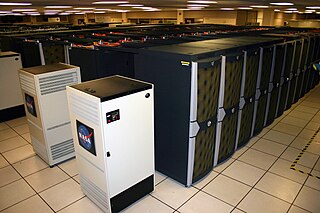
Pleiades is a petascale supercomputer housed at the NASA Advanced Supercomputing (NAS) facility at NASA's Ames Research Center located at Moffett Field near Mountain View, California. It is maintained by NASA and partners Hewlett Packard Enterprise and Intel.
System G was a cluster supercomputer at Virginia Tech consisting of 324 Apple Mac Pro computers with a total of 2592 processing cores. It was finished in November 2008 and ranked 279 in that month's edition of TOP500, running at 16.78 teraflops and peaking at 22.94 teraflops. It ran at a "sustained (Linpack) performance of 22.8 TFlops". It transmitted data between nodes over Gigabit Ethernet and 40 Gbit/s Infiniband.

The National Computational Infrastructure is a high-performance computing and data services facility, located at the Australian National University (ANU) in Canberra, Australian Capital Territory. The NCI is supported by the Australian Government's National Collaborative Research Infrastructure Strategy (NCRIS), with operational funding provided through a formal collaboration incorporating CSIRO, the Bureau of Meteorology, the Australian National University, Geoscience Australia, the Australian Research Council, and a number of research-intensive universities and medical research institutes.

Several centers for supercomputing exist across Europe, and distributed access to them is coordinated by European initiatives to facilitate high-performance computing. One such initiative, the HPC Europa project, fits within the Distributed European Infrastructure for Supercomputing Applications (DEISA), which was formed in 2002 as a consortium of eleven supercomputing centers from seven European countries. Operating within the CORDIS framework, HPC Europa aims to provide access to supercomputers across Europe.

Xeon Phi is a discontinued series of x86 manycore processors designed and made by Intel. It was intended for use in supercomputers, servers, and high-end workstations. Its architecture allowed use of standard programming languages and application programming interfaces (APIs) such as OpenMP.
Carter is a supercomputer installed at Purdue University in the fall of 2011 in a partnership with Intel. The high-performance computing cluster is operated by Information Technology at Purdue (ITaP), the university's central information technology organization. ITaP also operates clusters named Steele built in 2007, Coates built in 2009, Rossmann built in 2010, and Hansen built in the summer of 2011. Carter was the fastest campus supercomputer in the U.S. outside a national center when built. It was one of the first clusters to employ Intel's second generation Xenon E-5 "Sandy Bridge" processor and ranked 54th on the November 2011 TOP500 list, making it Purdue's first Top 100-ranked research computing system.
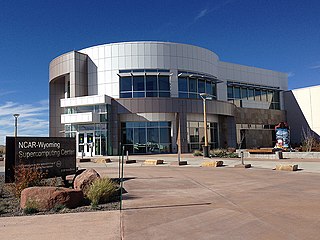
The NCAR-Wyoming Supercomputing Center (NWSC) is a high-performance computing (HPC) and data archival facility located in Cheyenne, Wyoming, that provides advanced computing services to researchers in the Earth system sciences.
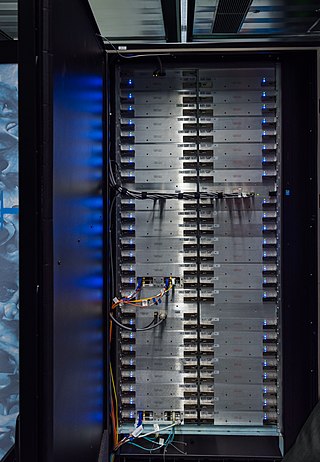
The Cray XC40 is a massively parallel multiprocessor supercomputer manufactured by Cray. It consists of Intel Haswell Xeon processors, with optional Nvidia Tesla or Intel Xeon Phi accelerators, connected together by Cray's proprietary "Aries" interconnect, stored in air-cooled or liquid-cooled cabinets. The XC series supercomputers are available with the Cray DataWarp applications I/O accelerator technology.
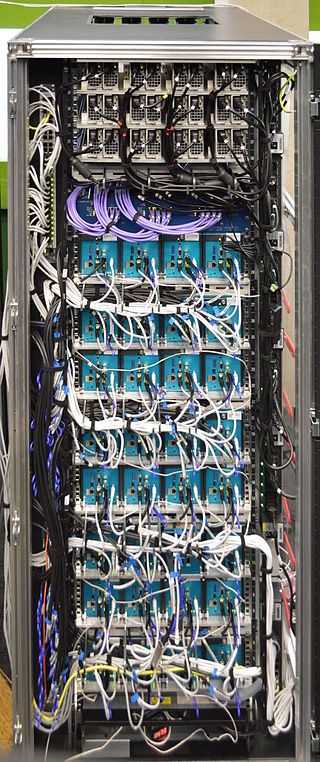
QPACE 2 is a massively parallel and scalable supercomputer. It was designed for applications in lattice quantum chromodynamics but is also suitable for a wider range of applications..
The Holland Computing Center, often abbreviated HCC, is the high-performance computing core for the University of Nebraska System. HCC has locations in both the University of Nebraska-Lincoln June and Paul Schorr III Center for Computer Science & Engineering and the University of Nebraska Omaha Peter Kiewit Institute. The center was named after Omaha businessman Richard Holland who donated considerably to the university for the project.
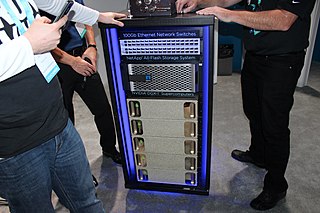
The Nvidia DGX represents a series of servers and workstations designed by Nvidia, primarily geared towards enhancing deep learning applications through the use of general-purpose computing on graphics processing units (GPGPU). These systems typically come in a rackmount format featuring high-performance x86 server CPUs on the motherboard.
Christofari — are Christofari (2019), Christofari Neo (2021) supercomputers of Sberbank based on Nvidia corporation hardware Sberbank of Russia and Nvidia. Their main purpose is neural network learning. They are also used for scientific research and commercial calculations.
Leonardo is a petascale supercomputer located at the CINECA datacenter in Bologna, Italy. The system consists of an Atos BullSequana XH2000 computer, with close to 14,000 Nvidia Ampere GPUs and 200 Gbit/s Nvidia Mellanox HDR InfiniBand connectivity. Inaugurated in November 2022, Leonardo is capable of 250 petaflops, making it one of the top five fastest supercomputers in the world. It debuted on the TOP500 in November 2022 ranking fourth in the world, and second in Europe.

Taiwania 3 is one of the supercomputers made by Taiwan, and also the newest one. It is placed in the National Center for High-performance Computing of NARLabs. There are 50,400 cores in total with 900 nodes, using Intel Xeon Platinum 8280 2.4 GHz CPU and using CentOS as Operating System. It is an open access for public supercomputer. It is currently open access to scientists and more to do specific research after getting permission from Taiwan's National Center for High-performance Computing. This is the third supercomputer of the Taiwania series. It uses CentOS x86_64 7.8 as its system operator and Slurm Workload Manager as workflow manager to ensure better performance. Taiwania 3 uses InfiniBand HDR100 100 Gbit/s high speed Internet connection to ensure better performance of the supercomputer. The main memory capability is 192 GB. There's currently two Intel Xeon Platinum 8280 2.4 GHz CPU inside each node. The full calculation capability is 2.7PFLOPS. It is launched into operation in November 2020 before schedule due to the needed for COVID-19. It is currently ranked number 227 on Top 500 list of June, 2021 and number 80 on Green 500 list. It is manufactured by Quanta Computer, Taiwan Fixed Network, and ASUS Cloud.












